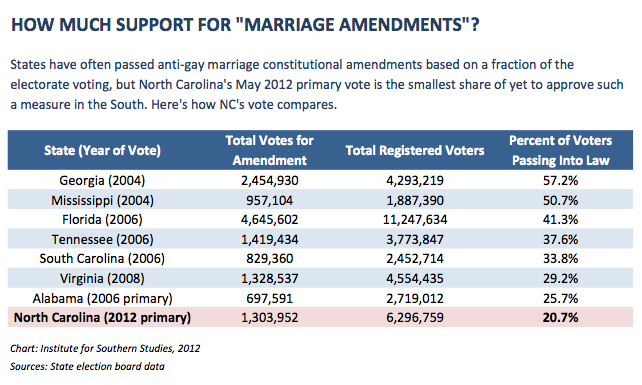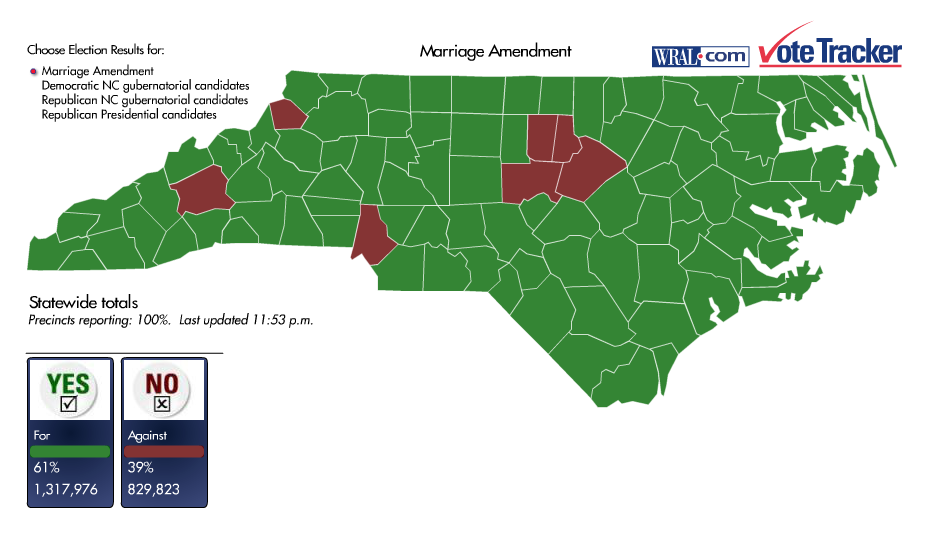What happened in North Carolina? Lessons from the amendment battle

Another version of this story also appears at The Huffington Post.
As expected, North Carolina voters passed a constitutional amendment yesterday stating “Marriage between one man and one woman is the only domestic legal union that shall be valid or recognized."
Polls had always shown the amendment had majority support, and across the country, even the most progressive states -- think California -- have tended to pass such measures.
But the amendment passed by an even larger margin than projected, 61 to 39 percent. And given that a blue-trending state like North Carolina has now gone against the national trend of states accepting gay marriage, the question remains: What happened in North Carolina?
Here are some quick takeaways from the amendment battle:
1) IT DOESN'T TAKE MUCH TO CHANGE THE CONSTITUTION
On May 8, just over 20 percent of North Carolina's registered voters cast a ballot in support of the amendment -- the lowest support of any amendment that's passed in Southern states. To put it another way, 14 percent of North Carolina's population decided the fate of all of the state's families.

How did that happen? It started in June 2011, when a Republican state legislator was accidentally caught on a live microphone telling GOP lawmakers they needed the amendment to "get their ground game working" for November 2012. The embarrassing admission that the amendment was about turnout and politics and not morality forced Republicans to offer a compromise -- which enough Democrats accepted -- of moving the amendment vote to the primary.
Moving the vote helped Republicans defuse the scandal and may help Democrats this November. But it likely doomed chances of defeating the amendment: Primary voters tend to be older; nearly 50 percent of early voters on May 8 were 60 or older, the demographic least sympathetic to gay marriage and civil unions. In primaries, groups with established turnout vehicles -- like evangelical churches -- also have a ready-made advantage.
2) THE POWER OF CONFUSION
Supporters of the amendment benefited greatly from confusion about what the measure actually does. An April 2012 poll by Public Policy Polling [pdf] infamously found that only 36 percent knew it would ban both gay marriage and civil unions; another 27 percent admitted they didn't know what the amendment would do, and a striking 10 percent actually thought it legalized gay marriage).
This was significant, because that and other polls [pdf] found that a majority of North Carolina voters supported civil unions, as in other states. In 2006, Arizona voters defeated a proposition that prohibited both gay marriage and domestic partnerships, like the N.C. amendment does. A bill focused just on gay marriage passed in Arizona two years later.
Pro-amendment groups like Vote for Marriage NC knew this, which is why they focused all of their campaign messaging around the dangers of "same-sex" unions. Many media outlets went along, slow to grasp the broader consequences of the bill and describing it largely in the shorthand of only gay marriage -- a bias that benefited pro-amendment forces.
The focus on gay marriage alone also drowned out the work of scholars like UNC's Maxine Eichner, which broke ground in documenting the unintended consequences of sweeping anti-domestic partnership bills.
3) A DIVIDED NORTH CAROLINA
In the end, just eight counties -- four centered around the Triangle progressive stronghold -- voted against the amendment. This map from WRAL in Raleigh tells the story:*

True, those counties -- defined by cities and college towns -- are where more than a quarter of North Carolina lives, which is the reason anti-amendment forces focused on mobilizing their base in these areas.
But the amendment found support in counties that were older, less urban and less diverse. Democratic consultant Gary Pearce sees the other key fault line as decisive: faith.
As he wrote before the vote:
If you live in a city, you might miss [the influence of evangelical Christians]. And it's not that opponents of the amendment aren't religious. Some surely aren't "churched," but those who go to church tend toward a belief system that emphasizes fairness and tolerance. "Fundamentalists" care more about order, tradition and morality. This moral conservatism runs deep in North Carolina's political DNA. You have to understand that to understand what's apparently about to happen.
Conservative evangelical groups -- with support from GOP uber-donor Art Pope -- had been rallying their church base around an anti-gay marriage/civil union amendment for nearly a decade. The 2010 Republican capture of the N.C. legislature finally gave amendment supporters the opening they needed, and a lower-turnout primary election was tailor-made for an election where having a reliable and easy-to-mobilize base could guarantee victory.
4) A GALVANIZING MOMENT
North Carolina's amendment passed by a larger margin than expected, but given the odds in its favor, it's remarkable it didn't win by a larger margin.
Anti-amendment forces, under the umbrella of the Coalition to Protect NC Families, built a formidable operation and remarkable coalitions in a short period of time.
Especially notable was the leadership of Rev. William Barber of the NAACP -- only the second state chapter to take leadership on such an amendment fight (California was the other). Barber joined the fight early and rallied African-American ministers and communities statewide, the NAACP's efforts complemented by organizing help from groups like All of US North Carolina.
The anti-amendment campaign faced the inevitable tensions and dilemmas, and a loss always invites second-guessing: How much of the message should focus on the amendment's attack on gay families, the amendment's clear target, versus the collateral damage to non-gay couples, a message with broader appeal? How much to focus on mobilizing sure supporters versus "persuadables" in the middle? More money for TV ads or grassroots organizing?
What the anti-amendment campaign definitely created is a stronger network of groups who have now gone through a bruising battle together and will emerge stronger to tackle future challenges, like the November elections.
Indeed, a law that was designed to pump up GOP turnout has ironically helped energize, coordinate and strengthen work among progressive groups in North Carolina, something which blogger (and Institute for Southern Studies board member) Pam Spaulding says will have impact far beyond Amendment One:
Building the coalition — assembling the diverse partners involved in this battle has been quite a handful, and it has paid off in dividends. The social justice infrastructure that has grown and been extended and is highly visible now — this can have lasting political repercussions for progressive politics in North Carolina — and that helps the equality movement nationally in the end.
* Here's an even better map by Jay Cagle showing the varying level of support among NC counties:

Tags
Chris Kromm
Chris Kromm is executive director of the Institute for Southern Studies and publisher of the Institute's online magazine, Facing South.
